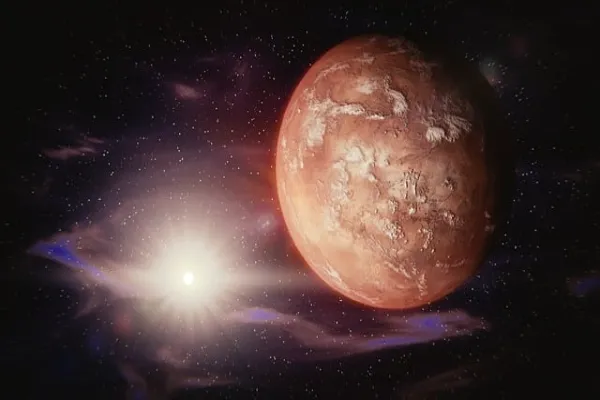10 Facts About Mars

Exploring the Red Planet: 10 Facts About Mars
Mars, the fourth planet from the sun and often referred to as the “Red Planet,” has long captivated the imagination of scientists and space enthusiasts alike. As humanity continues to explore the mysteries of our neighboring world, here are 10 facts about Mars as a celestial wonder:
1. Iron Oxide Canvas: Mars gets its distinctive reddish hue from the prevalence of iron oxide, commonly known as rust, on its surface. This iron-rich dust covers the Martian landscape, contributing to the planet’s striking appearance.
2. Olympus Mons: The Giant Among Giants: Mars hosts the largest volcano in our solar system—Olympus Mons. Towering at a staggering height of about 13.6 miles (22 kilometers), this shield volcano is nearly three times the height of Mount Everest on Earth.
3. Ancient Martian Rivers: Mars bears evidence of ancient riverbeds and valleys, suggesting that liquid water once flowed across its surface. The intricate network of channels hints at a dynamic past, sparking curiosity about the possibility of Martian life in the distant past.
4. Martian Polar Ice Caps: Similar to Earth, Mars has polar ice caps, but instead of water ice, these are composed of a combination of water and dry ice (frozen carbon dioxide). The seasonal changes in these polar caps, as they expand and contract with temperature variations, provide valuable insights into Mars’ climate.
5. Phobos and Deimos: Martian Moons on the Move: Mars has two small moons, Phobos and Deimos, which are irregularly shaped and thought to be captured asteroids. These moons are among the smallest in our solar system and have captured the attention of scientists exploring the dynamics of Mars’ gravitational influence.
6. The Tharsis Bulge: Tharsis, a massive volcanic plateau on Mars, is home to some of the largest volcanoes on the planet, including Olympus Mons. The presence of Tharsis creates a significant bulge on Mars, influencing its topography and geological features.
7. Global Dust Storms: Mars experiences intense dust storms that can envelop the entire planet. These global dust storms, while not uncommon, can dramatically alter the Martian landscape and impact the planet’s climate.
8. Methane Mystery: The detection of methane in Mars’ atmosphere has intrigued scientists, as methane is often associated with biological activity. The source of this methane remains uncertain, sparking ongoing investigations into whether it has geological or potentially biological origins.
9. Curiosity Rover’s Martian Adventure: NASA’s Curiosity rover has been exploring Mars since its landing in 2012. This robotic geologist has provided valuable data about the Martian surface, including evidence of past water activity and the composition of Martian soil.
10. Mars Colonization Dreams: Visionaries like Elon Musk have expressed ambitions to establish human colonies on Mars. While this remains a long-term goal, the idea of human exploration and potential settlement on the Red Planet has ignited imaginations and conversations about the future of interplanetary civilization.
Mars Unveiled: Exploring 10 Facts About Mars

Mars, the fourth planet from the Sun, has long been a focus of scientific exploration, captivating our curiosity with its unique features. One remarkable fact about Mars is its possession of the largest volcano in our solar system, Olympus Mons.
Towering at an astonishing height of about 13.6 miles (22 kilometers), this shield volcano stands as a testament to Mars’ dynamic geological history. Alongside Olympus Mons, Mars also boasts the Tharsis bulge, a massive volcanic plateau that significantly influences the planet’s topography, showcasing the intriguing interplay between geological forces on the Martian surface.
Mars has been a prime target for missions seeking signs of past or present life. The discovery of ancient riverbeds and valleys on the Martian surface suggests that liquid water once flowed across its terrain. This tantalizing clue fuels the speculation about the possibility of microbial life existing on Mars in the distant past.
The Martian landscape also reveals polar ice caps, providing crucial information about the planet’s climate and seasonal variations. As robotic explorers like NASA’s Curiosity rover continue to unravel the mysteries of the Red Planet, these ten facts about Mars contribute to our evolving understanding of this enigmatic world and its potential as a target for future human exploration.
As humanity’s understanding of Mars deepens through ongoing exploration, these 10 facts about Mars offer a glimpse into the diverse and dynamic nature of the Red Planet. From ancient riverbeds to towering volcanoes, Mars continues to be a focal point for scientific discovery and the exploration of our place in the cosmos.